 Original art by Keith S. Delaplane
Original art by Keith S. Delaplane- Honey Bee Biology
- Races of Honey Bees
- Preparing to Keep Bees
- Beekeeping Equipment
- Buying and Moving Colonies
- Installing Packaged Bees
- Catching Swarms
- Honey Bee Management
- Processing Honey
- Pollination
- Stings
- Honey Bee Diseases and Pests
- Unwanted Honey Bee Colonies
- Sources of Bee Supplies
- Reference Books
Honey bees (Apis mellifera L.) are one of the most well-known, popular and economically beneficial insects. For thousands of years, man has plundered honey bee colonies to get honey, bee larvae and beeswax. In recent decades, bee plundering has given way to bee management. Now, honey bees are commonly kept in artificial hives throughout the United States, and a large and sophisticated beekeeping industry provides valuable honey, beeswax and pollination services. A large section of the industry, well represented in Georgia, is devoted to mass-producing queens and bees for sale to other beekeepers. Although many people make a living from bees, most beekeepers are hobbyists who have only a few hives and who simply enjoy working with these fascinating insects.
Honey Bee Biology
Honey bees, like ants, termites and some wasps, are social insects. Unlike ants and wasps, bees are vegetarians; their protein comes from pollen and their carbohydrate comes from honey, which they make from nectar. Social insects live together in groups, cooperate in foraging tasks and the care of young, and have different types, or "castes," of individuals. There are three castes of honey bees:
Workers
Reproductively underdeveloped females that do all the work of the colony. A colony may have 2,000 to 60,000 workers.
 Worker.
Worker.
Queen
A fully fertile female specialized for producing eggs. When a queen dies or is lost, workers select a few young worker larvae and feed them a special food called "royal jelly." These special larvae develop into queens. The only difference between workers and queens is the quality of the larval diet. There is usually only one queen per colony. The queen also affects the colony by producing chemicals called "pheromones" that regulate the behavior of other bees.
 Queen.
Queen.
Drones
Male bees. A colony may have 0 to 500 drones during spring and summer. Drones fly from the hive and mate in the air with queens from other colonies.
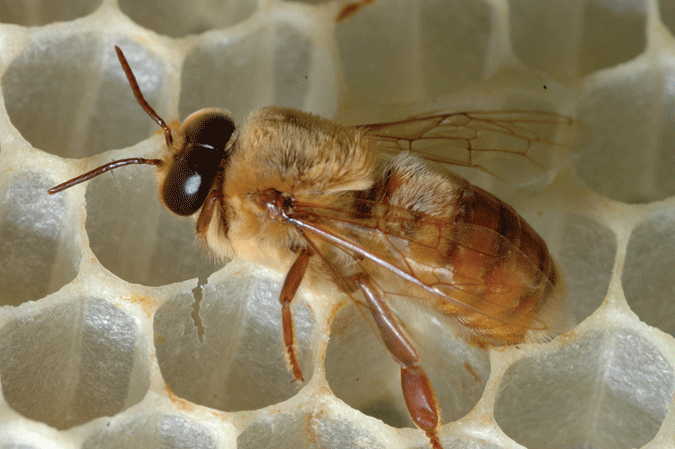 Drone.
Drone.The queen lays all her eggs in hexagonal beeswax cells built by workers. Developing young honey bees (called “brood”) go through four stages: the egg, the larva (plural “larvae”), the inactive pupa (plural “pupae”) and the young adult. The castes have different development times (Table 1).
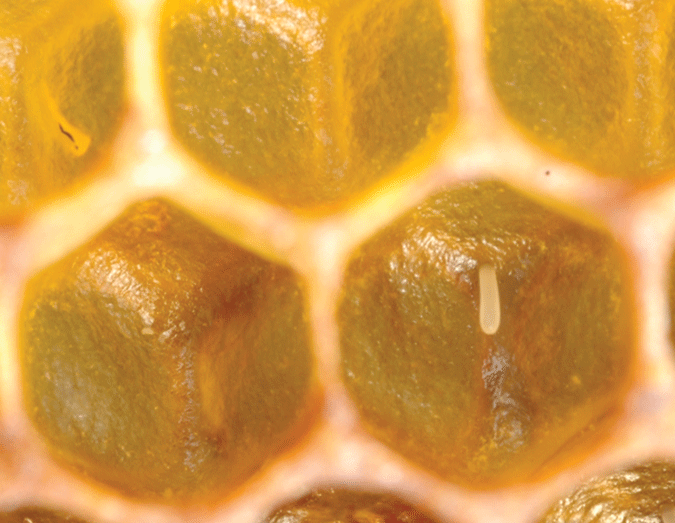 Egg. Egg. |
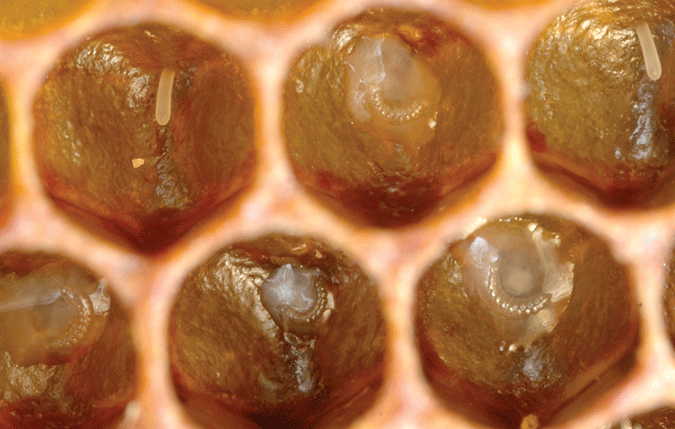 Young larvae. Young larvae. |
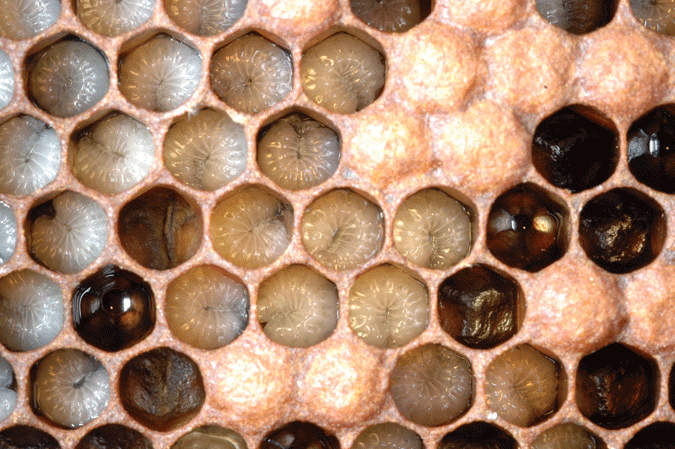 Mature larvae. Mature larvae. |
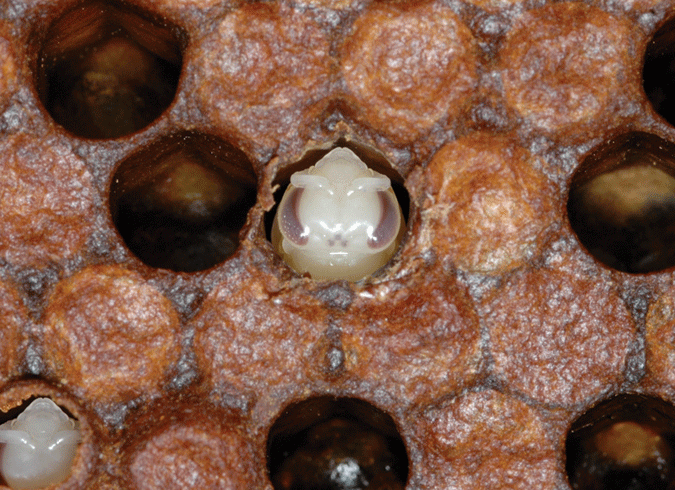 Pupa. Pupa. |
Newly emerged workers begin working almost immediately. As they age, workers do the following tasks, in this sequence: clean cells, circulate air with their wings, feed larvae, practice flying, receive pollen and nectar from foragers, guard hive entrance and forage.
Unlike colonies of social wasps and bumble bees, honey bee colonies live year after year. Therefore, most activity in a bee colony is aimed at surviving the next winter.
During winter, bees cluster in a tight ball. In January, the queen starts laying eggs in the center of the nest. Because stored honey and pollen are used to feed these larvae, colony stores may fall dangerously low in late winter when brood production has started but plants are not yet producing nectar or pollen. When spring "nectar flows" begin, bee populations grow rapidly. By April and May, many colonies are crowded with bees, and these congested colonies may split and form new colonies by a process called "swarming." A crowded colony rears several daughter queens, then the original mother queen flies away from the colony, accompanied by up to 60 percent of the workers. These bees cluster on some object such as a tree branch while scout bees search for a more permanent nest site - usually a hollow tree or wall void. Within 24 hours the swarm relocates to the new nest. One of the daughter queens that was left behind inherits the original colony.
| Table 1. Development time of honey bee castes. | |||
| Days after Laying Egg | |||
| Stage |
Worker
|
Queen
|
Drone
|
| Hatching |
3
|
3
|
3
|
| Cell capped |
8
|
8
|
10
|
| Becomes a pupa |
11
|
10
|
14
|
| Becomes an adult |
20
|
15
|
22.5
|
| Emerges from cell |
21
|
16
|
24
|
After the swarming season, bees concentrate on storing honey and pollen for winter. By late summer, a colony has a core of brood belowinsulating layers of honey, pollen and a honey-pollen mix. In autumn, bees concentrate in the lower half of their nest, and during winter they move upward slowly to eat the honey and pollen.
Races of Honey Bees
Honey bees are Old World insects that were introduced into North and South America by European settlers. The most well-known races of honey bees in the New World are:
Italian bees
Apis mellifera ligustica - Originally from Italy, this is by far the most popular honey bee. Italian bees are yellow in color, relatively gentle, overwinter well and build up quickly in spring. They are easily provoked to rob weaker neighboring colonies and sometimes exhaust honey stores rapidly in winter.
Carniolan bees
Apis mellifera carnica - These bees originated in the Austrian Alps, northern Yugoslavia and the Danube valley. Gray/brown in color, they are extremely gentle, conserve winter food stores well and build up quickly in spring. Carniolan bees construct new comb slowly and swarm frequently.
Caucasian bees
Apis mellifera caucasica - These bees originated in the Caucasus mountains between the Black and Caspian Seas. They are lead-gray in color, very gentle and swarm infrequently. Caucasian bees overwinter poorly, build up slowly in spring, are susceptible to Nosema disease and gum up their hives with propolis (tree resins and beeswax).
German black bees
Apis mellifera mellifera - Originally from throughout northern Europe, this was the first honey bee brought to the New World. They are brown/black in color and overwinter well. German black bees are nervous, aggressive and build up slowly in spring.
Africanized honey bee
Apis mellifera scutellata and its hybrids - These honey bees originated throughout east Africa. In the 1950s, this race was imported to Brazil and began migrating northward. Compared to European races, this bee and its hybrids are extremely defensive, have smaller nests and swarm more frequently. Africanized honey bees colonized certain regions of the United States in the 1990s.
Preparing to Keep Bees
Honey bees can be kept almost anywhere there are flowering plants that produce nectar and pollen. Choose a site for bee hives that is discrete, sheltered from winds and partially shaded. Avoid low spots in a yard where cold, damp air accumulates in winter. Your county Extension agent can give you names of local beekeepers and bee organizations that are sources of help and information.
Be considerate of non-beekeeping neighbors. Place hives so that bee flight paths do not cross sidewalks, playgrounds or other public areas. In dry weather, bees may collect water at neighbors' swimming pools or water spigots. Avoid this by giving your bees a water source in your yard such as a container with floating wood or styrofoam chips. The floating objects prevent bees from drowning.
Beekeeping Equipment
One new hive with bees and basic equipment costs about $150. Hive parts are cut to standard dimensions that mimic the space bees naturally leave between their combs. Always reproduce these dimensions exactly if you make your own bee hives. You will need the following equipment.
Bee hive
(Figure 1; click graphic for larger image), made up of:
- Bottom board - wooden stand on which the hive rests. Set bottom board on bricks or concrete blocks to keep it off the ground.
- Frames and foundation - wooden frames that hold sheets of beeswax foundation and are imprinted with the shapes of hexagonal cells. Bees use the foundation to build straight combs.
- Hive body or brood chamber - large wooden box (called a "super") that holds 10 frames of comb. This space (the brood nest) is reserved for the bees to rear brood and store honey for their own use. Either one or two hive bodies can be used for a brood nest. Two hive bodies are common in cold winter regions. Beekeepers in areas with mild winters successfully use only one hive body.
- Queen excluder - placed between the brood nest and the honey supers. This device keeps the queen in the brood nest, so brood will not occur in honey supers. An excluder is usually not necessary if two hive bodies are used.
- Honey supers - shallow supers with frames of comb in which bees store surplus honey. This surplus is the honey that is harvested.
- Inner cover - prevents bees from attaching comb to outer cover and provides insulating dead air space.
- Outer cover - provides weather protection.
Smoker
The most valuable tool for working bees. A smoker calms bees and reduces stinging. Pine straw, grass and burlap make good smoker fuel.
Hive tool
Ideally shaped for prying apart supers and frames.
Veil and gloves
Protect head and arms from stings. After they gain experience, most beekeepers prefer to work without gloves.
Feeders
Hold sugar syrup that is fed to bees in early spring and in fall.
Consult the list of addresses of bee equipment suppliers. Exterior wooden parts should at least be coated with good oil-based paint. To maximize the life of exterior parts, first dip them in copper naphthenate wood preservative, then paint them. Assemble interior frames with wood glue and nails.
 Figure 1. Plans and dimensions for a standard honey bee hive.
Figure 1. Plans and dimensions for a standard honey bee hive.
Buying and Moving Colonies
The easiest, and sometimes the best, way to start keeping bees is to buy two established colonies from a reputable local beekeeper. Buying two colonies instead of one lets you interchange frames of brood and honey if one colony becomes weaker than the other and needs a boost. Before buying, arrange to inspect the colonies. Ask the seller to provide a recent certificate of inspection from the state Department of Agriculture. Buy bees in standard equipment only. Competent beekeepers usually have one or two hive bodies on the bottom board with shallower honey supers above. Question the seller if supers are arranged differently. The condition of the equipment may reflect the care the bees have received, so be suspicious of colonies in rotten, unpainted wood. Once the colony is opened, the bees should be calm and numerous enough that they fill most of the spaces between combs.
Be sure each super has at least nine frames of comb. Inspect combs in the deep supers for brood quality. Capped brood is tan/brown in color. A good queen will have at least five or six combs of brood, and she will lay eggs in a solid pattern so that there are few skipped cells. Look for symptoms of brood disease and wax moth larvae (see the section on "Honey Bee Diseases and Pests").
Bee hives are easiest to move during winter when they are lighter and populations are low. Moving hives is a two-man job. Close the hive entrance with a piece of folded window screen, seal other cracks with duct tape, fasten supers to each other and to the bottom board with hive staples and then lift the hive into a truck bed or a trailer. Tie the hives down tightly. Remember to open hive entrances after the hives are relocated.
Installing Packaged Bees
Another way to start keeping bees is to buy packaged bees and queens and transfer the bees into new equipment. Bees are routinely shipped in 2- to 5-pound packages of about 9,000 to 22,000 bees. Once your packages arrive, keep the packages cool and shaded. Set up a bottom board with one hive body and remove half its frames. Make some sugar syrup (one part sugar:one part water) and spray the bees heavily through the screen; bees gorge themselves with syrup and become sticky, making them easy to pour. Pry off the package lid, remove the can of syrup provided for transit, find and remove the queen suspended in her cage and re-close the package. The queen cage has holes at both ends plugged with cork, and one end is visibly filled with white "queen candy." Remove the cork from this end and suspend the queen cage between two center frames in your hive. Workers will eat through the candy and gradually release the queen. Next, bounce the package lightly to shake all bees into a clump on the bottom, quickly take off the lid and shake the bees into the hive on top of the queen. As the bees slowly spread throughout the hive, gently return the frames you removed earlier. Carefully place the inner and outer covers on your new colony and feed your bees sugar syrup continuously until natural nectar flows begin. After two days, check to see if the bees have released the queen from her cage. If she was released, you will probably find her slowly walking on one of the center combs. If bees have not yet released her, return the queen cage to the hive until she is released. A week after the queen's release, check the colony again. By this time, you should find white wax combs under construction with cells containing syrup, eggs or young larvae. If you do not find eggs, the queen may be dead and she must be replaced immediately. Order another queen and introduce her as before.
Catching Swarms
Another way to get started is by finding and installing swarms. Sometimes swarms cluster on accessible places such as low tree branches, and property owners are usually eager for a beekeeper to remove them. If you find a safely accessible swarm, get a five-gallon plastic bucket with some kind of perforated cover such as window screening. Spray the swarm heavily with sugar syrup, place the bucket underneath it, then give the branch a sharp shake to dislodge bees into the bucket. Cover the bucket and install the swarm in a hive as you would packaged bees (except for the steps on installing a caged queen). Your county Extension agent will be glad to take your name as a referral for swarm calls.
Honey Bee Management
Management is scheduled around natural nectar flows. Beekeepers want their colonies to reach maximum strength before the nectar flows begin. This way, bees store the honey as surplus that the beekeeper can harvest instead of using the honey to complete their spring build-up. Nectar flows are very different between north and south Georgia (Table 2) so plan your beekeeping tasks according to the nectar flows in your area.
Feeding and medicating should be done from January through February. Queens resume laying eggs in January, after which brood production accelerates rapidly to provide the spring work force. Some colonies will need supplemental feeding. If colonies are light when you hoist them from the rear, they need sugar syrup. Mix syrup (one part sugar:one part water) and feed the bees heavily. Commercially available pollen supplements provide extra protein for population growth. Feed all medications (see the section on "Honey Bee Diseases and Pests") early enough to allow for labeled withdrawal periods before nectar flows begin.
By mid-February, the hives are ready for detailed inspection. On warm days (at least 45 degrees F), check the colonies for population growth, the arrangement of the brood nest and disease symptoms. Colonies with less brood than average can be strengthened by giving them frames of sealed brood from stronger neighbors. If you use two hive bodies, most of the bees and brood may be in the upper body with little activity in the bottom one. If so, reverse the hive bodies, putting the top one on the bottom. This relieves congestion and discourages swarming. If you use one hive body, relieve congestion by providing honey supers above a queen excluder. Swarming should be avoided because it severely reduces colony strength.
Mail-order queens are usually available by the last week in March. Annual requeening, whether in early spring or in fall, is one of the best investments a beekeeper can make. Compared to older queens, young queens lay eggs more prolifically and secrete higher levels of pheromones which, in turn, stimulate workers to forage, suppress swarming and suppress disease outbreak. To requeen a colony, find, kill and discard the old queen. Let the colony remain queenless for 24 hours and then introduce the new queen in her cage as described in the section "Installing Packaged Bees." With a new queen, you can also make a new colony by taking frames of brood, honey and bees from a strong colony (leaving behind the old queen), placing them in a new hive body with a new queen and then moving the new hive to a new location. This controlled "splitting" of a colony lets a beekeeper manage the swarming process; congestion and the swarming urge are relieved in the strong colony, and the removed bees are housed in a managed hive instead of lost.
If you feed your colonies, medicate them, requeen them and control swarming, they should be strong enough to collect surplus nectar by mid-April. This is the time to add honey supers above the hive bodies. Add plenty of supers to accommodate incoming nectar and the large bee populations; this stimulates foraging and limits late-season swarming. As nectar comes in, bees place it in cells and evaporate it to about 18 percent water content. When bees cap the honey, it is considered ripe. At harvest time, use commercially available bee repellents to drive bees from the supers.
Not all honeys are alike. Usually, lighter honeys command higher prices, and most beekeepers try to keep darker honeys from mixing with lighter ones. For example, beekeepers in north Georgia remove supers with dark tulip poplar honey before it can mix with incoming sourwood honey, which is lighter. Consult Table 2 and local beekeepers to determine the proper time to remove your honey.
During late summer and early autumn, brood production and honey production drop. Unlike in spring, you should now crowd the bees by giving them only one or two honey supers. This forces bees to store honey in the brood nest. Colonies are usually overwintered in two hive bodies or in one hive body and at least one honey super. If you overwinter in one hive body and a honey super, remove the queen excluder so the queen can move up into the honey during winter. Colonies should weigh at least 100 pounds in late fall. If they are light on stores, feed them a heavy syrup (two parts sugar:one part water).
| Table 2. Major Pollen & Nectar Sources of Georgia. | ||
| Months | Plant | Provides |
| North & Central Georgia | ||
| February | maple | pollen, nectar |
| March | dandelion | pollen |
| April | black locust | nectar |
| April - June | clovers* | nectar |
| mid April - mid May | tulip poplar | nectar |
| late June - July | sourwood * (in mountains) | nectar |
| late September | goldenrod | pollen, nectar |
| South Georgia | ||
| January - February | maple | pollen, nectar |
| February - March | spring titi | nectar |
| early April | black gum tupelo* | nectar |
| April | tulip poplar | nectar |
| late April | high bush gallberry* | nectar |
| May | low bush gallberry* | nectar |
| late May | palmetto | nectar |
| late July | pepper bush, soybean | nectar |
| September-October | goldenrod | pollen, nectar |
| * Premium honeys | ||
Processing Honey
Honey is sold as "extracted" honey - bottled, liquid honey that has been extracted from the combs; "comb" honey - honey still in its natural comb; and "chunk" honey - a bottled combination of extracted and comb.
Honey extracting equipment for the hobbyist is specialized and represents a one-time investment of about $500 for new equipment. Used equipment is often available at significant savings. These are the basic tools and procedures for extracting honey:
- Uncapping knife - A heated knife for slicing off the cappings from combs of honey.
- Uncapping tank - A container for receiving the cappings. Wet cappings fall onto a screen, and honey drips through to the bottom of the tank and out a spigot.
- Extractor - A drum containing a rotating wire basket. Uncapped combs are placed in the basket and the basket is turned by hand or by motor. Honey is flung out of the combs onto the sides of the tank and drains through a spigot.
- Strainer - A mesh of coarse screen or cloth directly under the extractor spigot. This filters out large debris such as wax and dead bees.
- Storage tank - A large tank with a spigot, or "honey gate," at the bottom. As honey settles in the tank, air bubbles and small debris rise to the top and can be skimmed off, allowing honey that is bottled from the honey gate to be clear and attractive.
Sometimes extracted honey granulates. This is a natural process, and the honey is still perfectly edible. If bottled honey granulates, loosen the lid and place the jar in a pan of water on a stove. Heat and stir the honey until it re-liquifies.
Comb honey requires little specialized equipment, so it is a good way for a new beekeeper to get started. Supply companies offer special comb honey supers for producing comb honey in round or square 1-pound sections. "Cut-comb" honey is the easiest and least expensive honey to produce. With cut-comb, the entire comb is cut away from the frame then further cut into smaller sections and packaged in special plastic boxes. Regardless of these variations, all comb honey requires a special extra-thin foundation. Freeze comb honey overnight before it is sold to kill any wax moth eggs and larvae.
Chunk honey is made by placing a piece of cut comb honey in a jar and filling up the rest of the jar with extracted honey. Remember to freeze the comb honey first.
Wax cappings are a valuable by-product of extracting. After cappings have dripped dry, wash them in water to remove all honey. Melt the cappings, strain the wax through cheesecloth and pour it into bread pans or a similar mold. Supply companies can render your beeswax bricks into new foundation at considerable savings.
Pollination
Many valuable crops benefit from insect pollination (the transfer of pollen from one flower to another flower). This process increases fruit yield and, often, the size of the fruit. Honey bees are important pollinators because they can be managed and easily moved to crop sites. In the United States, the added value to agriculture from honey bee pollination is more than $9 billion annually, and many beekeepers earn extra income from renting colonies for pollination. In Georgia, bee hives are rented to pollinate apples, blueberries, cucumbers and watermelons. Professional recommendations vary for the number of hives needed for good pollination, but for these crops one colony per acre is commonly used.
Stings
Anyone who keeps bees will inevitably get stung. Consider this before you invest in a beekeeping hobby. You can greatly reduce stinging if you use gentle, commercially reared queens, wear a veil, use a smoker and handle bees gently. Experienced beekeepers can handle thousands or even millions of bees daily and receive very few stings.
A bee sting will cause intense local pain, reddening and swelling. This is a normal reaction and does not, in itself, indicate a serious allergic response. With time, many beekeepers no longer redden or swell when they are stung (however, it still hurts!). An extremely small fraction of the human population is genuinely allergic to bee stings. These individuals experience breathing difficulty, unconsciousness or even death if they are stung and should carry with them an emergency kit of injectable epinephrine, available by prescription from a physician.
When a bee stings, the stinger and poison sack remain in the skin of the victim. Always scrape the stinger and poison sack out of the skin with your fingernail or a hive tool (Figure 9); never pull it out because this squeezes the remaining venom into the skin.
Honey Bee Diseases and Pests
Honey bee brood and adults are attacked by bacteria, viruses, protozoans, fungi and exotic parasitic mites. Additionally, bee equipment is attacked by other insects. Disease and pest control requires constant vigilance by the beekeeper. By law, all colonies in Georgia must be registered with the Georgia Department of Agriculture. Every beekeeper is responsible for contacting the Department for an inspection at least once every 18 months (every 12 months for queen and package bee producers). See your county Extension agent for help in registering and inspecting your hives.
American foulbrood
American foulbrood (AFB) is a bacterial disease of larvae and pupae. The bacteria form highly persistent spores that can be spread by adult bees and contaminated equipment. In
Status and Revision History
Published on Jan 01, 1991
In Review for Minor Revisions on Mar 12, 2009
Published on Mar 22, 2010
Published with Full Review on Jan 27, 2014
Published with Full Review on Mar 31, 2014
Published with Minor Revisions on Apr 11, 2017


























































